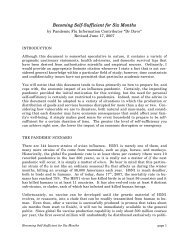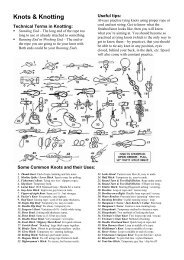Create successful ePaper yourself
Turn your PDF publications into a flip-book with our unique Google optimized e-Paper software.
ABOUT MUSHROOMS<br />
rooms fall upon a favorable place and begin to grow. If the soil<br />
is fairly uniform, an approximately circular patch of mycelium<br />
develops. After a few years mushrooms spring up near the outer<br />
border of this circle. Each year the mycelium advances regularly<br />
outward, and mushrooms again arise at its outer edge, thus forming<br />
an ever-growing fairy ring. Lack of uniformity in the soil or<br />
accidents of one kind or another may interrupt the regular outward<br />
growth of mycelium during the passage of years, so that<br />
few large complete circles are formed, although people have<br />
found some that were more than fifty feet across. By measuring<br />
the rate of advance over a period of years botanists have calculated<br />
that some of these fairy rings are almost four centuries old.<br />
Thus these fragile and transitory fruit bodies that are born, mature,<br />
and die in the shortness of a day spring from roots that may<br />
outlive many generations of men.<br />
<strong>Mushrooms</strong> reproduce chiefly by means of spores. The mushroom<br />
as we know it is merely the fruit body of the plant; its function<br />
is to produce the largest number of spores in the shortest<br />
possible time and liberate them into the air. These spores are similar<br />
to the seeds of higher plants, but they differ from seeds in the<br />
simplicity of their structure and in their very small size. A typical<br />
mushroom spore is a single, thin-walled cell about 1/2,500 of an<br />
inch long, so small and light that it can be wafted about by the<br />
slightest breeze.<br />
When a spore alights on the ground where moisture and food<br />
are available, it absorbs water, swells, and forms a protuberance on<br />
one side; this grows into a long filament, or hypha. The hypha<br />
may Jive for a short time on the food stored in the spore, but the<br />
spore is so small that this reserve food is not sufficient for more<br />
than mere inception of growth. The filament continues to grow<br />
and eventually forms a dense network of branched mycelium.<br />
Many species of mushrooms form slowly just beneath the surface<br />
of the soil, developing over a period of weeks or even<br />
months. When they are almost completely formed, if there is<br />
enough moisture present, the stem elongates rather suddenly and<br />
7
















